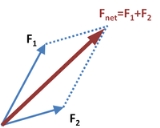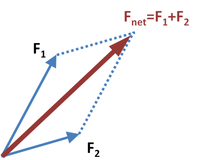
Parallelogram of force
Encyclopedia

Parallelogram
In Euclidean geometry, a parallelogram is a convex quadrilateral with two pairs of parallel sides. The opposite or facing sides of a parallelogram are of equal length and the opposite angles of a parallelogram are of equal measure...
of forces is a method for solving (or visualizing) the results of applying two force
Force
In physics, a force is any influence that causes an object to undergo a change in speed, a change in direction, or a change in shape. In other words, a force is that which can cause an object with mass to change its velocity , i.e., to accelerate, or which can cause a flexible object to deform...
s to an object. When more than two forces are involved, the geometry is no longer parallelogrammatic, but the same principles apply. Forces, being vectors are observed to obey the laws of vector addition, and so the overall (resultant) force due to the application of a number of forces can be found geometrically by drawing vector arrows for each force. For example, see Figure 1. This construction has the same result as moving F2 so its tail coincides with the head of F1, and taking the net force as the vector joining the tail of F1 to the head of F2. This procedure can be repeated to add F3 to the resultant F1 + F2, and so forth.
See also
- Vector (geometric)
- Net forceNet forceIn physics, net force is the total force acting on an object. It is calculated by vector addition of all forces that are actually acting on that object. Net force has the same effect on the translational motion of the object as all actual forces taken together...
- Head to Tails method

